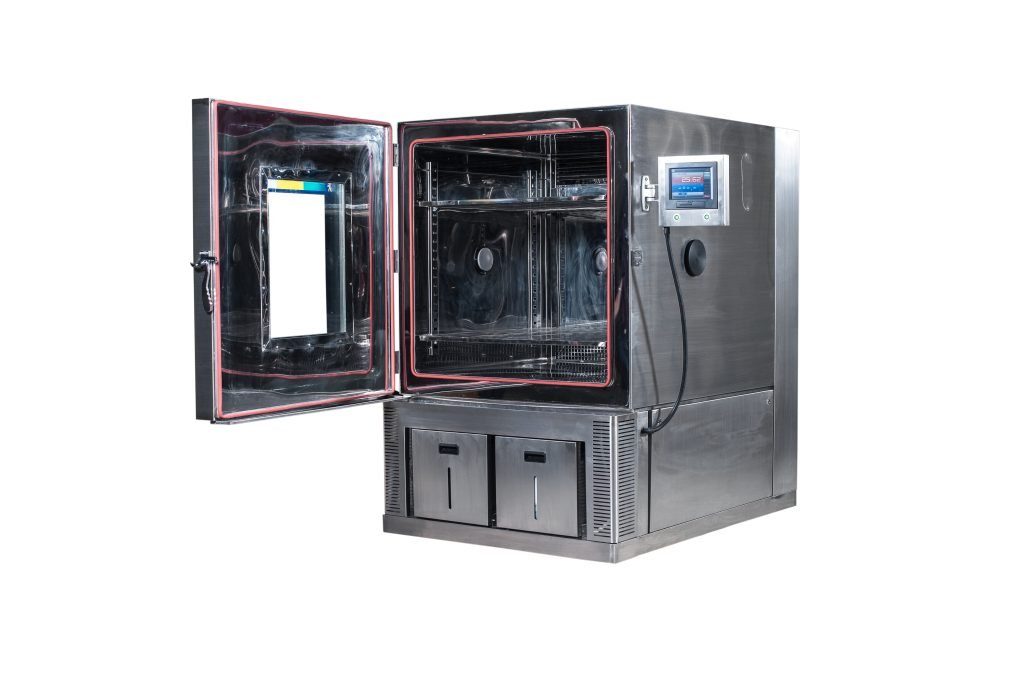Environmental chamber are one of the most essential laboratory equipment used in many cutting-edge industries, for both research and development (R&D) in production phases. Also known as climatic test chambers, they are enclosed chambers where temperature, humidity and other environmental conditions are replicated. This allows products, materials, and other biological specimens to be tested in a range of simulated environmental conditions. Temperature and humidity chambеrs havе many applications across divеrsе industriеs and research fields.
We, at Testron Group, are a leading supplier of environmental chambers in the USA. Our global expertise spans globally in countries like, Europe, Saudi Arabia, India, South Africa, UAE & China. Here we will answer questions commonly asked by our industry-leading clients.
Environmental Chamber FAQs
1. What are the main types of environmental testing chambers?
Here’s a breakdown of some key types with features to consider:
Salt Spray Corrosion Test Chamber:
- Simulates exposure to salt-laden environments like ocean air.
- Features: Adjustable salt spray concentration, fog distribution systems, programmable cycles for replicating real-world conditions.
Accelerated Weathering Test Chamber:
- Mimics the effects of sunlight, temperature, humidity, and rain on materials.
- Features: Light sources replicating sunlight spectrum (UV, visible, infrared), precise temperature and humidity control, spray systems for simulated rain.
Dust and Rain Test Chamber:
- Evaluates a product’s resistance to dust ingress and water penetration.
- Features: Adjustable dust types and concentrations, spray nozzles for rain simulation, variable wind speeds.
Ozone Test Chamber:
- Tests a material’s ability to withstand ozone exposure, common in polluted environments.
- Features: Controlled ozone concentration levels, temperature and humidity control for combined stress testing.
SO2 H2S CO2 Corrosion Chamber:
- Specifically designed to assess resistance to specific gases like sulfur dioxide (SO2), hydrogen sulfide (H2S), and carbon dioxide (CO2), relevant in industrial settings.
- Features: Precise gas mixing and concentration control systems, safety features for handling hazardous gases.
Walk-in Test Chamber:
- Large chambers for testing bigger products or even full-scale systems under controlled conditions.
- Features: Accommodate entire products or assemblies, may include access doors and internal lighting for observation during testing.
Industry Drying Oven:
- Primarily used for drying or baking materials at controlled temperatures, often used in industrial processes.
- Features: Wide temperature ranges, precise control systems, optional features like ventilation or inert gas purging.
Temperature and Humidity Test Chamber:
- One of the most common types, it precisely controls temperature and humidity levels.
- Features: Wide temperature and humidity ranges, independent control of each parameter, data logging capabilities for monitoring test conditions.
Thermal Shock Test Chamber:
- Rapidly cycles between extreme temperature conditions to assess a product’s ability to withstand thermal stress.
- Features: Fast temperature change rates, high and low temperature extremes, programmable cycles for simulating specific environments.
By understanding these key features, you can choose the most appropriate environmental testing chamber for your specific needs.
2. What are the different parameters that can be controlled in an environmental chamber?
Some common parameters that can be controlled in an environmental chamber include:
- Temperature: Wide ranges, typically -80°C to 180°C+ (depending on chamber)
- Humidity: Precise control, often 10% to 95% Relative Humidity (RH)
- Light Dosage: Simulates sunlight spectrum (UV, visible, infrared) for photostability testing.
- Cryogenic Conditions: Ultra-low temperatures, down to -196°C (liquid nitrogen)
- Sun Exposure: Mimicked with calibrated light sources for specific wavelengths and intensity.
- Corrosion: Simulated with controlled salt spray, gas injection (SO2, H2S, CO2), etc.
- Precipitation: Simulated with spray systems for rain testing, adjustable for volume and intensity.
- UV Exposure: Precise control of ultraviolet (UV) radiation for degradation testing.
- Thermal Shocks: Rapid temperature cycling between extremes (-80°C to +180°C possible in some chambers).
3. What type of water should be used in an environment test chamber?
Environmental test chambers should use demineralized or single distilled water for optimal performance. The water used should have specific ranges for resistivity, conductivity, and total dissolved solids (TDS) to ensure compatibility and prevent maintenance issues. Here are the specifications for the type of water that should be used in an environmental test chamber:
- Resistivity: 0.05MΩ * cm to 6MΩ * cm
- Conductivity: 20µS to 0.167µS
- Total Dissolved Solids (TDS): 10 ppm to 1 ppm
Using properly filtered water is essential to maintaining the integrity of the test chamber and ensuring consistent and reproducible test results. Most city water is not suitable for use in humidity chambers, so it may be necessary to use a water demineralizer system or a water recycling system to ensure the water meets these specifications.
4. What are the different sizes and temperature ranges of environmental chambers?
Environmental chambers come in a variety of sizes and temperature ranges. Reach-in chambers can range in size from 0.5 ft3 to over 70 ft3 and can create almost any environment, including temperature, humidity, altitude, rain, solar, and vibration.
5. What are the benefits of environmental test chambers?
Environmental test chambers, also known as climatic test chambers or testing chambers, are laboratory equipment that simulates different environmental conditions in a controlled space. This allows scientists and manufacturers to get an accurate idea of how their product will react under different conditions.
Leading Environmental Test Chamber Manufacturers – Testron Group
At Testron Group, we understand the importance of ensuring your products can withstand real-world challenges. That’s why we’re a leading manufacturer of environmental test chambers, built with precision and reliability.
Our commitment to quality is reflected in our accreditations:
- SCK Certifications
- IAS Accreditation MSCB 244
- IAF Member of Multilateral Recognition Arrangement
- ISO 9001:2015 Certified
We offer a wide range of chambers to meet your specific testing needs, from temperature and humidity control to simulating harsh environmental conditions.
Contact Us
If you need more information, please contact our team info@testrongroup.com.
Also Read: Ensure A Smooth Chamber Installation Process With Testron.


